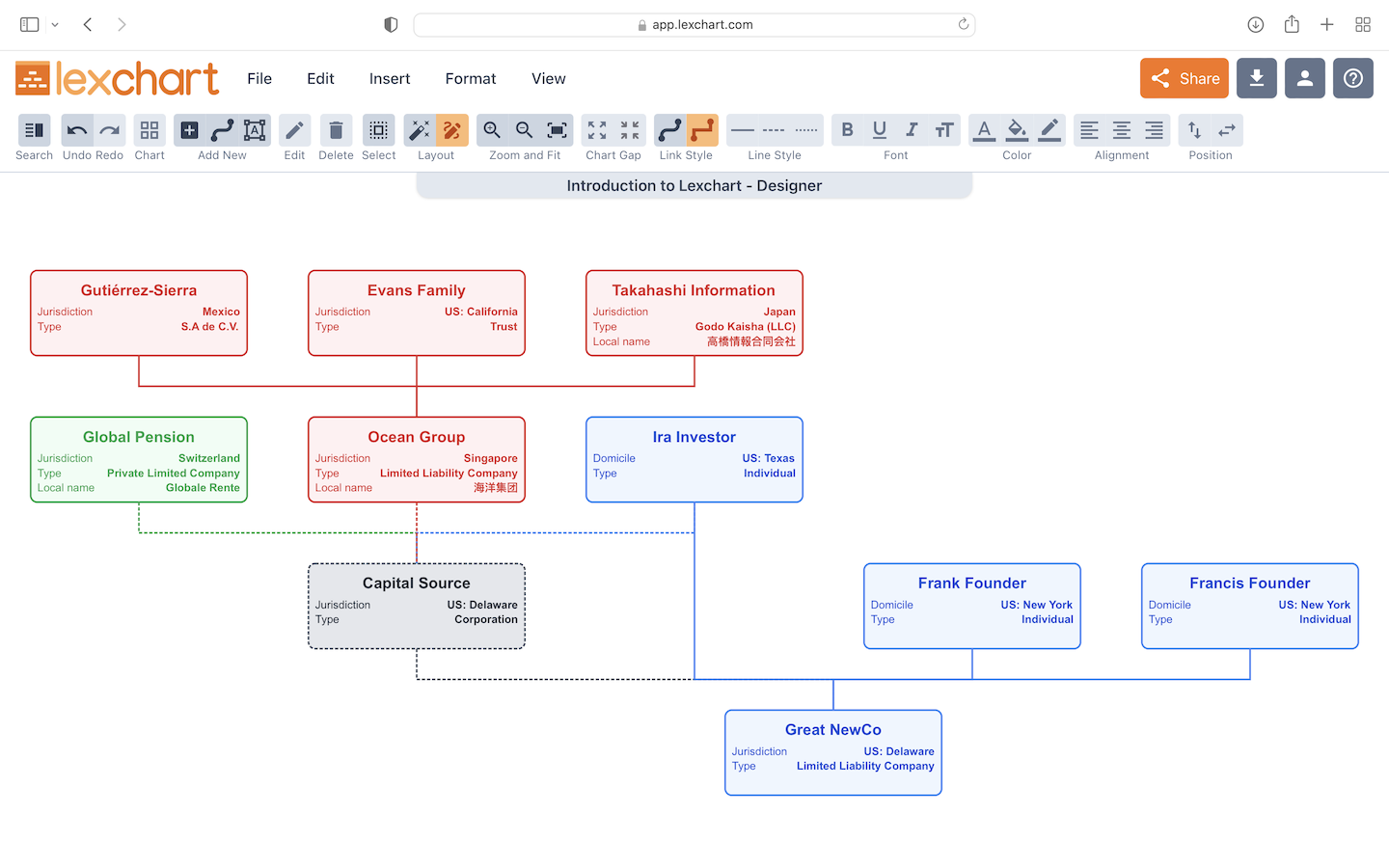Decoding Subsidiaries: A Deep Dive into Company Structure Charts

Navigating the corporate world can feel like deciphering a secret code. One term you've likely come across is "subsidiary", often tucked away in articles about large conglomerates, mergers, or acquisitions. But what are subsidiaries, really? Why do they matter? And, more importantly, how can you visualize and understand them better?
From tech giants like Google to automotive behemoths like General Motors, many companies utilize subsidiaries as part of their corporate strategy. It's a compelling structure that can confer numerous benefits but also poses unique challenges.
In this comprehensive guide, we will unravel the enigma of subsidiaries. We will dive deep into what subsidiaries are, how they function, their different types, and why businesses use them. Plus, we'll incorporate practical, visual aids from Lexchart's company structure charts to bring the abstract concept of subsidiaries into a clear, concrete format.
Understanding Subsidiaries: The Basics
A subsidiary is a company owned by another company. The owning company is known as the parent company.
Parent companies might own more than half of the subsidiary's stock. This gives them control of the subsidiary.
Legally, a subsidiary is its own entity. It can sue and be sued. It can sign contracts. And it can buy and sell property. The parent company can make decisions for the subsidiary, because the parent company controls the subsidiary's board of directors.
The relationship between parent companies and subsidiaries is complex. The parent company generally, but not necessarily, has control. The subsidiary operates independently.
The subsidiary can have its own management. It can also have its own employees.
In essence, a subsidiary is a separate company. But it's controlled by another company. This relationship allows for flexibility. It gives the parent company control while allowing the subsidiary to adapt to its local market, fill a strategic need, or manage risk for the broader enterprise.
A parent company can have many subsidiaries.
Types of Subsidiaries
Subsidiaries come in different forms, and their classification is often based on the extent of ownership by the parent company. Here are the common types:
Wholly-Owned Subsidiaries
A wholly-owned subsidiary is entirely owned by the parent company. That means the parent company owns 100% of the subsidiary's stock. This gives the parent company total control over the subsidiary's operations. The parent can make all decisions, from strategic direction to day-to-day operations.
Wholly-owned subsidiaries might be created through the acquisition of an existing company. The parent company might establish them from scratch. In either case, this structure allows the parent to fully reap the subsidiary's financial rewards.
Wholly-owned subsidiaries generally protect the parent from risk of business failure or legal issues, unless parent's involvement allows for "piercing the corporate veil."
Majority-Owned Subsidiaries
A majority-owned subsidiary is one where the parent company owns more than 50% but less than 100% of the subsidiary's stock. This gives the parent company control over the subsidiary but also involves other shareholders.
While the parent company can still guide the subsidiary's strategic direction, it must also consider the interests of other owners. Despite this, the parent company has enough voting power to influence or even control major decisions.
The owners or investors which are not the majority owner are called the minority owners.
Minority-Owned Subsidiaries
A minority-owned subsidiary is a company where the parent company owns less than 50% of the subsidiary's stock. This means the parent company doesn't have direct control over the subsidiary's operations. However, it can still influence the subsidiary through its stake.
In a minority-owned subsidiary, the parent company is a significant investor but cannot make unilateral decisions. It may be able to elect some board members and influence some decisions, but it must work with other owners. This type of subsidiary can offer strategic benefits, like market entry or technology access, without the need for total control.
It is possible for no single owner or investor to have majority control. The effect is that enough owners need to agree to make management decisions.
The Role and Benefits of Subsidiaries
Subsidiaries are integral components of a company's growth strategy. They facilitate expansion without altering the operations of the main business. Let's delve into their key benefits:
Strategic Advantage
Subsidiaries can grant parent companies access to new markets. A company may create a subsidiary in a different region or country to cater to local business norms and regulatory landscape. This separation also allows for financial independence, which is crucial when venturing into potentially risky markets.
Financial Benefits
Creating a subsidiary can also lead to financial advantages. Since subsidiaries are separate legal entities, they provide a financial shield for the parent company. If the subsidiary faces financial challenges, the parent company is generally protected. This separation can be particularly advantageous in risky industries or new ventures.
Depending on the legal structure of the parent and subsidiary, the structure can also create tax benefits.
Legal and Risk Management
The distinct legal status of a subsidiary can also help with risk management. Any legal issues faced by the subsidiary typically do not impact the parent company directly, offering a layer of legal protection. Having a subsidiary allows companies to manage, isolate, and mitigate business risks effectively.
Autonomy and Flexibility
Even though subsidiaries are under the control of their parent companies, they often have a degree of autonomy. This allows them to adapt quickly to their local market conditions, innovate, and respond to customer needs effectively. This agility can give companies a competitive edge in rapidly changing marketplaces.

Setting Up a Subsidiary: Steps and Considerations
Creating a subsidiary involves a series of steps and considerations. Here's a general outline of the process:
The Process of Creating a Subsidiary
Planning: The first step is to identify the objectives for creating a subsidiary: new markets, risk management, or another objective.
Choosing a location: Depending on the objectives, the parent company must decide where to establish the subsidiary. This could be in a different state or country.
Incorporation: The parent company must legally incorporate the subsidiary. This involves registering the subsidiary with the local government, which may require filing documents and paying fees.
Capitalization: The parent company must provide the subsidiary with its initial capital. This is usually done by purchasing the subsidiary's stock.
Appointing a Board of Directors: The parent company appoints the subsidiary's board of directors. These individuals will oversee the subsidiary's operations.
Legal and Business Considerations
Setting up a subsidiary involves many legal and business considerations. For example, the parent company must consider the tax implications of creating a subsidiary. It also must consider local laws and regulations.
Operating subsidiaries which conduct business will need to consider employment law and practices in a new market or jurisdiction.
The Role of Entity Management in Maintaining Subsidiaries
Once a subsidiary is set up, managing it becomes a key task. This is where entity management comes in. It involves keeping track of the subsidiary's legal obligations, ensuring compliance with local laws, and managing relationships with the subsidiary's stakeholders. In a larger corporation with multiple subsidiaries, effective entity management is crucial for smooth operations.
From Abstract to Concrete: Understanding Subsidiaries through Lexchart's Structure Charts
As we delve deeper into the world of subsidiaries, having a visual guide can be invaluable. Lexchart's company structure charts provide just that.
Introduction to Lexchart's Company Structure Charts
Lexchart's company structure charts offer a graphical representation of the relationship between a parent company and its subsidiaries. These charts provide an easy-to-understand visual layout of how a company is structured, making the abstract concept of corporate structure concrete.
How to Read and Understand These Charts
To read Lexchart's structure charts, start at the top, where you'll find the parent company. Lines or arrows point from the parent company to its subsidiaries. These subsidiaries can have their own subsidiaries, represented by further lines or arrows leading from them.

The charts may also use color-coding or data to indicate the type of subsidiary or the proportion of ownership. Lexchart company structure charts do not need a legend because information about parents, subsidiaries, and their connections can display information directly.
Examples of Subsidiaries in Lexchart's Charts
You'll find numerous examples of the different types of subsidiaries in Lexchart's charts. These real-world examples provide invaluable insights into how companies use subsidiaries to further their business strategies. By studying these charts, you can develop a deeper understanding of how and why companies set up different types of subsidiaries.

The Legal Entities Involved: Parents and Subsidiaries
The corporate structure is a diverse landscape that consists of various types of legal entities. Both parent companies and subsidiaries can take on multiple forms, leading to a myriad of permutations.
Types of Legal Entities for Parent Companies
A parent company can be any legal entity, including:
Corporations: This is a common type of legal entity for large businesses. Corporations can have shareholders, are subject to specific tax structures, and provide limited liability.
Limited Liability Companies (LLCs): An LLC is another popular choice for businesses. It offers flexibility in tax structures and limited liability without the stringent requirements of corporations.
Partnerships: This includes General Partnerships, Limited Partnerships, and Limited Liability Partnerships. These entities are governed by agreement between two or more parties who share in the business's profits and losses.
Each type of legal entity has its unique features, benefits, and considerations, influencing which structure a business chooses when setting up a parent company.
Types of Legal Entities for Subsidiaries
Just like parent companies, subsidiaries can take various legal forms:
Corporation Subsidiaries: A parent company might set up a subsidiary as a separate corporation. This provides the benefits of a corporate structure, including limited liability and ease of transferability.
LLC Subsidiaries: In some cases, a subsidiary may be an LLC. This provides flexibility, especially with taxation and management structures.
Partnership Subsidiaries: Less common but still possible, a parent company might set up a subsidiary as a partnership, offering unique benefits depending on the partnership type.
The choice of legal entity for a subsidiary will depend on several factors. These include the business goals, the industry, the specific legal and financial context, and the risk profile. The combination of different types of legal entities for parent companies and subsidiaries creates a wide range of possible corporate structures. Each structure brings its unique advantages and challenges.
Subsidiaries vs Other Business Entities
Subsidiaries are one way for a company to structure its business. But they're not the only way. In this section, we'll compare subsidiaries to other types of business entities, namely divisions and affiliates.
Comparison Between Subsidiaries, Divisions, and Affiliates
Subsidiaries are separate legal entities owned in part or in full by another company.
Divisions are parts of a company that operate in a specific market or region, or that provide a specific product or service. Unlike subsidiaries, they are not separate legal entities. They are simply a part of the parent company.
Affiliates are companies in which another company owns a significant, but not controlling, stake. Affiliates operate independently, but the investing company may have influence over their operations.
Each of these structures has its benefits and considerations. The best choice depends on the company's specific circumstances and objectives.
Criteria for Choosing the Right Corporate Structure
Choosing the right corporate structure is a complex process. It depends on many factors, including:
Business objectives: The company's goals will influence the structure. For example, if a company wants to enter a foreign market, it might choose to create a subsidiary in that country.
Risk tolerance: Different structures come with different levels of risk. A company must consider its risk tolerance when choosing a structure.
Legal and tax implications: Different structures have different legal and tax implications. It's important for a company to understand these implications before deciding on a structure.
Operational needs: A company's operational needs can also influence the structure. For example, if a company needs a high degree of control over a new venture, it might choose to create a subsidiary rather than an affiliate.
In the end, the choice of structure is a strategic decision. It requires careful consideration and, often, the advice of legal and business experts.
The Role of Subsidiaries in Mergers and Acquisitions
Subsidiaries often play a significant role in mergers and acquisitions (M&A). This section will explore how they factor into these strategic decisions and the associated legal and financial implications.
How Subsidiaries Can Play a Role in M&A Activities
Subsidiaries can be the target of an acquisition or a tool used in the process of a merger or acquisition. For example:
Acquisition Target: A parent company may decide to sell a subsidiary as a separate entity. This allows the parent company to raise capital, shift focus, or divest from a non-core business.
Acquisition Vehicle: In some cases, a parent company might use a subsidiary to acquire another company. This allows the parent company to isolate the acquisition and its associated risks.
Merger Vehicle: Similarly, a parent company might merge a subsidiary with another company. This allows the parent company to combine operations without affecting the rest of its operations.
Legal and Financial Implications
There are significant legal and financial implications to using subsidiaries in M&A activities. On the legal side, the process must comply with laws and regulations regarding securities, antitrust, and foreign investment, to name a few. Financially, the parent company must consider the impact on its balance sheet and cash flow. It must also consider tax implications.
These implications make M&A activities involving subsidiaries complex. Companies often need the assistance of legal and financial experts to navigate these transactions successfully.
Conclusion
Subsidiaries play a significant role in the corporate world. As we've seen, they offer strategic advantages, financial benefits, and risk management. They provide flexibility and allow companies to explore new opportunities without putting the entire business at risk.
This chart is made with Lexchart for automatic organization charts.


